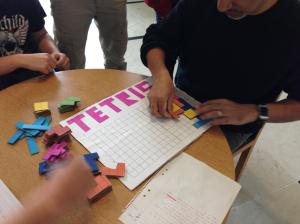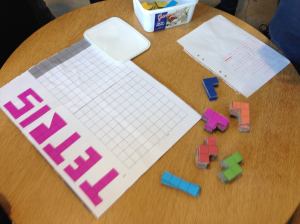Tetris
We began with analyzing the different components of the game, in order to construct the game we had to deconstruct it first.
We agreed on that the core experience of the game consisted of: stress, management and problem solving.
The “risk versus reward choises” was in our oppinon: the correct position, vertical acceleration, rotation/correct angle.
As for the aesthetics we decided that puzzle-solving, challenge, submission, sensation and stress was the main factor.
The mechanics consisted of horizontal movement, rotation and time.
In our case the time was the main issue. The Translation of time from a digital game to a board game is not an easy task. We tried different versions of the game, such as involving action points, dependent on x amount of rounds. We also tried to use dice to determine time and location. The last method that we used was the use of timers. With other words we took use of actual time.
When the analyzing process was done, the actual tryout began. We made a text document in word, consisting of squares in different colors which we later on printed in A4 format.
Then we cut all the pieces out according to the digital Tetris game, we wanted the board game to appear as authentic as possible. Which in itself was a difficult task.
The process took place from around 17pm to 22pm. It was intense, but me and my team worked very effectively, therefore the great results.
The next day we gathered in the library to check if there was any faults in the game. We tried to play it a few times and noticed that the pieces, consisting of paper, where to light. To avoid that problem we attached them on to cardboard. It made them heavier and therefore more easy to place on the board.
A couple of hours later the presentation took place. Every team from the class displayed their game in the library. We were supposed to stay and describe our game and later on go and try out the other ones.
The rules: The board consists of squares in which you have to fit the Tetris pieces. You have three seconds to place the piece at the desired position, a piece that is spawned from one in the design team, who also counts the seconds. The player can pause the game whenever she likes, to correct the structure of the pieces. In this version, the row that is full, does not vanish. But instead you are supposed to cover the whole board until it reaches the top. When it does, the game stops and the player counts all the full rows and convert them to points.
As people came to our table to try the game, we took some notes. A total of 13 players tried our game. Here are the notes:
Person 1: Reaction: stress, fun, challenge. Feedback: Fun, difficult(in a good way).
Person 2: Re: It became messy in the beginning, it was good that the paus function was available. Feed: more time is needed, though the stress has to be there.
Person 3: Re:stress, confused about the colors. Feed: Fun, stress, nice that you could paus, 3 seconds works well.
Person 4:Re: stress, paused many times. Feed:fun and stress, little bit messy.
Person 5: Re: stress(good), really feels like Tetris. Feed:good with paus application, hard to distinguish between the colors
Person 6: Har to get a grip of the pieces, Tetris feeling.
Person 7:stress
Person 9: (Adam Mayes, our teacher) Thought that it really captured the Tetris feeling, felt authentic. Very good!
Person 10: Nice game!
Person 11: really likes the 3 second rule, very stressful .
Person 12: Did not want us to have the logo of “Tetris “on the board, appart from that; very fun.
Person 13: Magnet would be good, very funny.
The feedback was amazing and we learned very much from it. The elements that we agreed on during the analyze, appeared in the reactions. When we compared the reaction of the player to our analysis, we came to the conclusion that the game was very successful.
The task was very challenging and fun. It gave a little bit of insight of how it is to work in a team.


